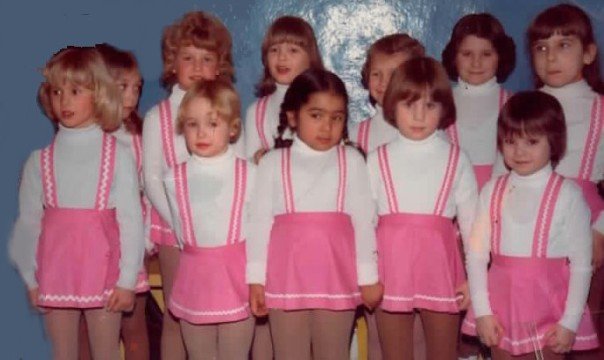Recently, I travelled through five continents in seven weeks starting in North America, then South America, then into Africa, Asia and Europe. For me, it was a time to look outwards: discover what culture means in this increasingly globalized and homogenous world. But just when you think you are looking at other people, they are looking at you. They were making determinations on who I was based on what I looked like and what they could gather from me. What my “heritage” was, or rather what they imagined my heritage to be.
So, it’s always great fun crossing a border as people try to figure out what I am. Spanish or English or American, or whatever. And being a female travelling alone also challenges people’s conceptions.
First, let me introduce myself. I was born in small-town British Colombia. At the age of four, I started my decade-long figure skating lessons after my abrupt career as a ballerina ended. I spent hours at the rink hanging out at the mall buying makeup and clothes, and singing classical music in choirs. Also, I spent most of my life moving across Canada studying domestic politics.
But I live in Québec, where I have been for almost half of my life, so people ask me about my country. By my country, they mean India. Complete strangers will ask me how to get Indian rice to be saffron-coloured. Or what my favourite Indian restaurant is. I am an expert on “my country” even though I have actually spent more time in Europe.
Don’t get me wrong. I have no sense of inferiority and don’t abide by the cliché that I am some kind of confused “coconut” (brown on the outside, white on the inside) anxiously straddling two worlds. I have had thorough training in Indian politics and culture.
I remember the exhausting one-city-a-day India tours where my father would show me how the British stole the gold and all the engineering secrets from Indian monuments, or the spellbinding Ajanta Buddhist caves built in the second century B.C. Before there was electricity or tools of any kind, Buddhist artisans built four- or five-story statues in the middle of a cave.
“Look at those caves,” my father would say, “The Western world thinks that they have a civilization. Indian civilization was much more complex, much richer and much older than theirs.”
When I was seven, I was gifted with an Indian comic book celebrating a school kid who shot the Indian Viceroy’s representative with a gun hidden in her textbook.
Indians also are confused by me. The word they use to describe me is “cosmopolitan.” Or they assume that I am Bengali because of my last name. To many in the West, India is one blob, and they easily confuse Iraq, India, Algeria and any other Eastern country as having one common culture involving exoticism, belly dancing and really shiny fabrics.
But to an Indian, your identity is your state: Bengal or Tamil Nadu. The goal is to try to marry someone from your state who speaks your language. So my “Bengali” father isn’t even really from West Bengal – he grew up in a few states, as a minority. And my mother is from another minority community: the Punjabi Hindu. They aren’t even from the same caste. I didn’t even know what caste was until I was a teenager. My mother had told me only “backwards” people believed in caste in modern India.
Step One: North America
Leaving Montréal with Air Canada in high season means getting into bilingual arguments at the airport. Of course they switch to English on me, because they assume that I am not from Québec and that I am of Indian decent. Even though I insist.
The plane lands in Punta Cana—not my destination choice, but Aeroplan’s—full of mostly French Québécois tourists trying to catch some sun. The woman beside me on the plane looks worried: “Vous parlez français?” Yes, I say, and start a conversation with her. She looks relieved.
In Punta Cana, I catch a bus to the beach. It is one of those places where, even if I attempt to speak Spanish, the locals are so used to English-speaking tourists that it is useless to try. People are very concerned that my husband isn’t here with me. To them, I am yet another Canadian tourist they will entertain with Cuban salsa music, Mexican tacos and lots of booze – as if they don’t have their own Dominican culture. Since this is only a stopover, I deal with these minor horrors and enjoy the emerald green waters.
Step Two: South America
I am going through another stopover in Sao Paulo, Brazil on the way to Buenos Aires, Argentina. Because I am addicted to coffee, in the Sao Paulo Airport Starbucks, I decide that I have to give them a name that they can pronounce or I will be there forever. (When your name is Sujata, you never give your real name to a barista). So I give them Susanna, which comes out as Suzana. I am intrigued how even in the airport almost no one knows English and all speak Portuguese. In fact, all through Brazil I am able to communicate only in slow Spanish. That would never happen in Québec.
In the Sao Paulo airport, the policing begins. They pull me off the flight – at the gate as I am boarding. My visa for Argentina is apparently incorrect. They take my luggage off the flight, as well. But then they change their mind and privately chauffeur me to the plane so I don’t miss it. This airport will repeatedly throw me off planes. In a very multiracial but also very segregated society, I wonder if that has anything to do with my skin colour.
In Argentina, as I am collecting my luggage I get stopped by a policeman, a jolly older man who sees that I must not have much money as a dark woman. He is concerned that I have also passed through the Dominican Republic, a known drug haven. Exhausted from the red-eye flight, I explain, in Spanish, my trip around the world, what I do for a living and how I can travel so much. He asks me where I am from. “Montréal,” I say. He then turns to his colleagues in Spanish, “Ahh, she’s French. That explains it.”
Argentina sees itself as an extension of Europe, and was populated mostly by European settlers. It is also a place that expels and arrests activists, as it did with many of the civil-society people coming to Buenos Aires for the World Trade Organization talks. And it is a place where I cannot leave home without my passport because I have to be able to validate my identity continuously.
I am having problems with Argentinian Spanish and the Argentinian pronunciation of words.
Pollo (chicken) is not pronounced poyo but posho. Try ordering a “pollo Roquefort.” When I ask for a “poyo rokfor,” the waiter corrects me: “Posho rokfort.” The taxi driver requests a translator because I ask him for the street (calle) as “cayé” and not “cashé.” Because of my odd pronunciation and my darker complexion, many of the waiters have concluded that I am Brazilian. I am also getting an awful lot of free drinks because I’m sitting by myself. Ordering. While female. It’s not all bad.

“Valparaiso” © Sujata Dey
As I head to Chile, I start to blend in with people. As my ex-boyfriend was Chilean, I feel very at home there. At the bank machine, people ask me in Spanish about bank procedures. It is only when they hear me answer with my accent that they realize that I don’t actually live there.
I am getting kissed and hugged a lot as I come face-to-face with various expressions of Latin American exuberance. Because Spanish people cannot pronounce Sujata, (soo JAtha), I am used to going by Suhata in Cuba and Mexico. But because of German migration to Chile, I am now Suyata. After heading off from Chile to Rio de Janeiro and Sao Paulo, I end up getting kicked off another flight. This time, it’s my flight from Sao Paulo to Addis Ababa, Ethiopia, and from Addis Ababa to New Delhi.
They say that my Aeroplan tickets are fake. Of course, they only do this at the gate, close to midnight, less than an hour before the plane leaves. They take away my boarding passes and haul my luggage off the plane. After getting Aeroplan on the phone and fighting with them, my boarding passes are reinstated. Again, I will never know why they targeted me twice in that same airport. Were they looking for a bribe from a “rich” Canadian, or did they believe that “someone like me” couldn’t possibly buy an airline ticket?
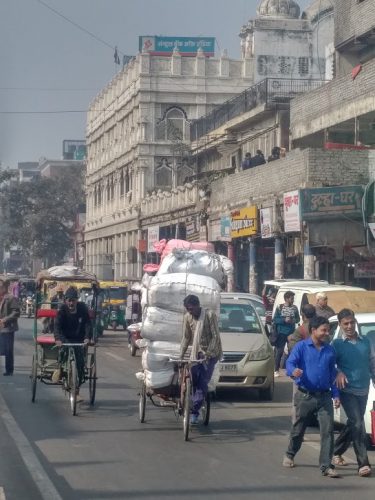
“Old Delhi” © Sujata Dey
A small step in Africa
The plane to Addis Ababa is filled with two groups of people transiting through Addis: Brazilians wanting to visit India, and people of Indian descent going to India. Africans make up only a small fraction of the passengers on the plane.
In Addis, they won’t let me out of the airport because the stopover is too short. But there is much to observe in the airport: stalls of artisan products, and duty-free shops. It is a busy gateway to Africa, with many people flying on Ethiopian Airlines to get to their African destination.
In the airport, there are many dress styles: women dressed in full veil, others in colourful African prints, others wearing business suits with shawls draped over them, and many people in jeans and t-shirts or suits.
Because the airport is in a country with a large Muslim minority, there are men’s and women’s prayer spaces. But there is also an airport synagogue. With significant Chinese investment and infrastructure coming into Africa, the restaurants include one with Chinese lettering. I am not able to leave the airport, but at least I can enjoy an Ethiopian meal.
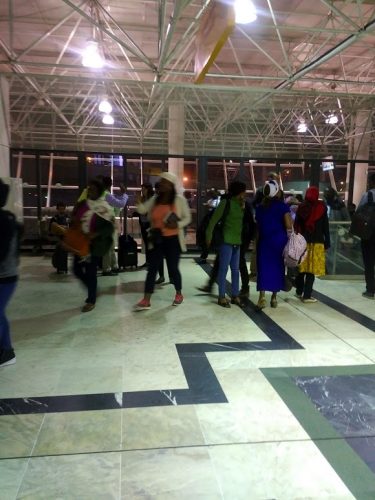
“Addis Ababa” © Sujata Dey
Asia, or rather India
After flying for two days, I wanted a shower and a bed, but that was not to be. As we land, I look down and cannot see New Delhi. Strange.
Soon the reason becomes clear. We are landing in Jaipur, a city in the northwest India. The explanation: the “weather.” Apparently the “fog” is so bad that planes cannot land. Thousands of flights have been diverted. The smelly, brown fog produced by the abundant waters of the desert surrounding Delhi is certainly not smog. The government adamantly denies that Delhi is the most polluted city in the world. But whatever.
We are held for hours on an airport apron in Jaipur. The Brazilians are holding back their urge to start a revolution by singing. The Indians are threatening to call the Chief Minister if we are held any longer. At this point, I feel it necessary to help the poor Brazilians translate what is going on and what might happen to them if we do get out in Jaipur. The Indians are most upset that there was no “khanna” or food during this horrid ordeal. The Brazilians on the plane are lovely, but strangely, all white in a multiracial society.
As we get into New Delhi finally, I sweep through customs with my Overseas Indian Citizen Card. It basically allows to me to be treated as an Indian citizen except that I don’t have the right to vote. So now, now the Québécois are right: I am an Indian and this is my country. But the bar was set fairly low for me to get this “citizenship.” I didn’t have to master any Indian language or have any knowledge of the country’s history or government. I only had to prove that my father was born in India and that he was duly married to my mother.
New Delhi is filled with us “cosmopolitans”— people from different states. There are a lot of migrants from other states, from Tibet, from China. There are kids in schools who do not yet master Hindi, the main language in Delhi, as their parents came there to find work.
If in Latin America I am dark and therefore have to be wary of how I am received, in New Delhi I am lighter skinned, upper middle-class and educated. Indians are used to my group of people whom they call non-resident Indians. In the middle class, everyone has family in Canada, the U.S., the U.K. or Australia.
Taking up public space while female is a daily battle. On the metro or aboard planes, there are 12 men for every woman. One of my aunts is very concerned that I am going out by myself even though Delhi has definitely improved since an internationally notorious rape case five years earlier.
And Indian men in public spaces are frustrating. They take my seat and refuse to move. They cut in front of me in lines. They sit in the seat and take up half of mine. They talk in the middle of the musical and get angry when women tell them to be quiet.
And they stare. They are constantly staring at me.
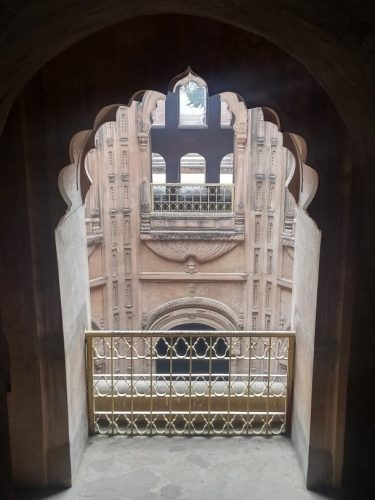
“Lucknow” © Sujata Dey
In Lucknow, my female cousin and I go to a bar that serves food. In true chauvinist style, they don’t give us the drink menu. We insist on it and I order rum just to spite them. The waiter is incredulous. Imagine that. A woman! Ordering! Alcohol! In a bar!!
But these are superficial problems compared to the plight of many minority, lower-caste and poor women who receive the lion’s share of gendered violence. India is a paradox. On the one hand, some women can be CEOs, Prime Ministers or Hindu goddesses and are immune from the problems faced by most women, while others are child brides or child prostitutes. In my family, everyone—male or female—has post-secondary education, while innumerable others can’t even get primary education. Also, in India of late, which is scapegoating and targeting Muslims for discrimination, I am part of the upper-caste Hindu majority.
Next step, Europe
From India, I took a flight through Dubai to Istanbul. In the last three years, I have often been on the road in Europe, working with the Council of Canadians against the Canada-Europe free trade deal. I was in Paris a block away from the Bataclan attack. I was in Barcelona on Spanish election night. I narrowly missed an attack in the Istanbul airport, and was often in Brussels walking through security checkpoints and past tanks. I spent months hearing stories and trying to understand what happens in Europe; I studied in France.
In the beginning of my work trips, I could practically run through Europe without a passport. No one bothered to stop anyone at the border. Often, if I did encounter border controls, I only had to show them the cover on my Canadian passport. But things have changed.
Coming into Turkey with a one-way ticket makes you an instant suspect. Often it is a sign that you are going to jump the border to join ISIS in Syria. Turkey has rigorous security protocols to keep terrorists from passing through on their way to the “caliphate” and to prevent migrants trying to escape to Europe in the other direction. Entering Bulgaria by train involves four hours of checkpoints in the middle of the night. Now, many countries check you both on entry and on exit.
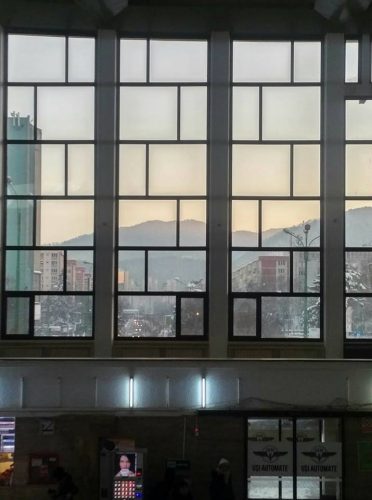
“Brasov, Romania” © Sujata Dey
Central and Eastern Europe are not known for being kind to Roma or immigrants, but they seem to like Canadian tourists. I travel from Sophia, Bulgaria, to Bucharest, Sighisoara and Brasov in Romania before heading to Budapest. In a train going to rural Romania, where no one speaks English or French, guys help me with my heavy baggage. A woman tries to make conversation with me in Romanian. I try to speak in a hybrid of French and Spanish until it makes sense. I learn that hora is hour and sept is seven, and figure out approximately how to tell the time in Romanian.
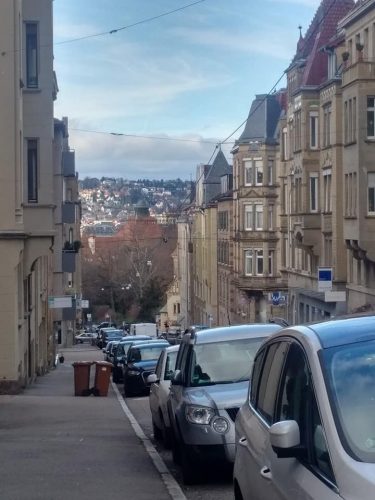
“Stuttgart” © Sujata Dey
From Budapest, I then head to Western Europe: Vienna, Stuttgart, Strasbourg and Paris. As I move west, immigration becomes more and more evident, and yet the architecture reflects fewer Muslim and more Christian influences. It is ironic that the eastern part of Europe has more Muslim influences and yet is more allergic to Muslim immigration.
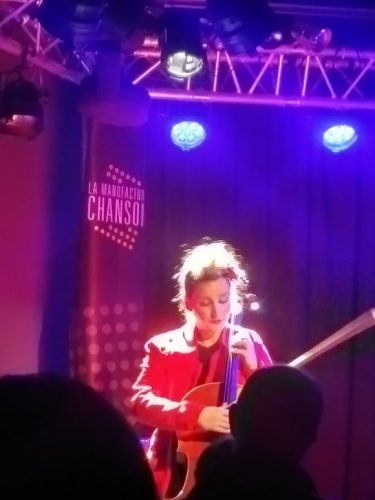
“Paris” © Sujata Dey
A few other things happen as you move west. The infrastructure becomes easier and more predictable, but the price tag increases. I limit my time in Western Europe for this reason. The further east you go, the more you have to push, tell people off, hop onto unofficial buses, make purchases on the black market and negotiate your way with cash, not credit cards.
And the selfie-carrying international tourists become more prominent. In this whole mix, I am classified in the category of “generic North American tourist,” American or Canadian. Same dif. Not a migrant. Not one of the poor immigrants working as a caretaker of a building, or any of the immigrant taxi drivers who confide to me that they want to migrate to Canada because of the difficulties living in Europe. But again, we tourists are also welcome to visit, but not to live.
And going into Western Europe also means more familiarity. Attitudes and infrastructure are similar. As we head into France, because I once lived there and speak the language, I have a sense of license and duty to fight and debate with people, critique everything, and not just be an observer. In France, they hear my Québécois expressions and turns of phrase and recognize that I am from Québec.
At last, I am recognized as a Québécoise. Just not in Québec!
Back in Québec
So back in Québec, people are very interested about my quest to find my roots. They want more stories of butter chicken. They want more recipes! Stories of my childhood on the veranda under my mother’s sari.

“Sujata greeting Michelle Bachelet” © Sujata Dey
When I tell them I met Michelle Bachelet, the president of Chile, they look disinterested. When I tell them that I went to a formal ball in Austria, they are fascinated by the fact that I wore an Indian ball gown, there. People seem interested in two things: my heritage or theirs.
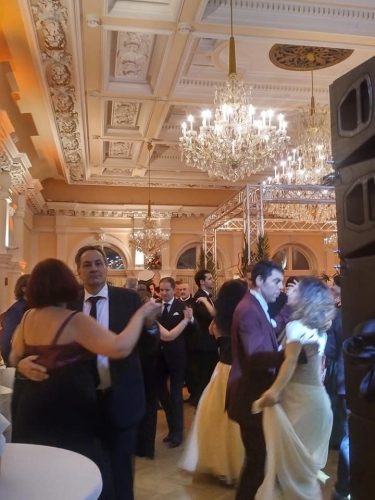
“Viennese ball” © Sujata Dey
There is a difference between the global quest to assimilate everyone into people wearing Gap jeans in a nondescript shopping mall, and the quest to reclaim one’s true identity. Like many worldwide, my story is one of hybrid identities, of nomads, of minorities within minorities. A reality that is becoming more the norm.
In travelling, I realize two things. First, regardless of how I might see myself, other people are going to decide what my heritage or identity is. And those perceptions or misperceptions of me will change based on what culture I am in. Secondly, I see my “heritage” is multipolar. I have degrees of familiarity with different cultures. I often put it in percentages. While others here would say I was 99% Indian, I would assign it a much lower percentage of my total “heritage.”
For me, my “heritage” is a sum of every experience and every culture that I have been exposed to, my education, my childhood, my travels, my friends, my family, and the cities I have lived in. It isn’t just my “biological” ancestry, but the cultural content within my head. And the more I travel and the more “heritage” I acquire, the less sense I make to people around me.
[The title of the essay is from the great Cole Porter song, “Don’t Fence Me In.”]
